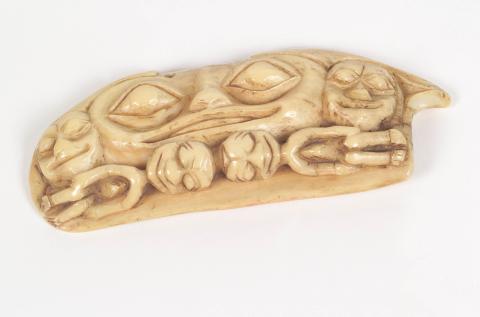Spirit Face Amulet
This piece is made from a whale’s tooth a type of ivory which is softer than other types. It is 4.625 inches or 11.74cm long. Sometimes amulets were left with the patient but could only be moved or removed by an íxt’.
This object was stolen from an íxt’s grave near Hoonah by G.T. Emmons. The carver of this piece is different than for the other pieces and Emmons raided two different íxt’ graves that were located close together. It might be possible that one carver worked for one íxt’ and another carver worked for the other the other íxt’ especially when looking at the stylistic differences of the two different artists’ work and the fact we know there two separate íxt’ graves. According to Emmon’s notes this piece was collected before 1888, carved possibly circa. 1820
Visions and spirit helpers came to íxt’s during their life and those that were important the íxt’ would depict them in their objects of healing or into objects to combat the dark side.
The iconography of this piece shows it to be a happy or friendly spirit and the surrounding faces are similarly designed. Although a lot of the time the íxt’ was working against the dark side there were times of the of joy the íxt’ would be involved in also. Manipulating forces of good and evil were both within the realm of an íxt’ and they needed to have objects of power for both.
Manufacture: Tlingit [Hoonah (Huna)].
NOTE: OTHER HANDWRITTEN: As described in Emmons' object notes (see 1920.0164 Source Catalog.pdf): "Ivory charm of a section of whales tooth carved to represent three faces beneath which are represented two small figures. The central face with the two on each side represents the spirit above Kewar khu which was most powerful. This was the spirit charm of a shaman which he wore suspended around his neck when treating the sick and bewitched and represents what he saw in a dream or trance and was supposed to possess a supernatural power. It might be touched to the patient or left with him in the absence of the shaman. It formerly belonged to a Tlingit shaman of the Hoonah tribe and was found in a shaman's grave house near Gaudahkan, Port Frederick."
Formerly in the collection of and probably collected by Lieutenant George T. Emmons (1852-1945, US Navy 1881-1899) at an unknown date; purchased by MAI from George T. Emmons in 1920 with funds donated by MAI trustees James B. Ford (1844-1928) and Harmon W. Hendricks (1846-1928).
References: [Book] Wardwell, Allen. 1996. Tangible Visions: Northwest Coast Indian Shamanism and its Art. 336.
Object illustration & reference: Page 172; No. 204
Tlingit Amulet. Emmons (n.d., Notes, NMAI) identifies the large face in the center as "the spirit above." Collected by him from the grave house of a Hoonah shaman near Hoonah. Whale tooth; length 4 5/8 inches; c. 1820 - 50. National Museum of the American Indian, Smithsonian Institution. Washington D.C., 9/7953. Purchased from Emmons, 1920.
[Book] Collins, Henry B., et al. 1977. The Far North: 2000 Years of American Eskimo and Indian Art. 298.
Object illustration & reference: P. 228; Fig. 284
Shaman’s Charm: Pectoral Ornament Ivory 11.7 (4 5/8) Long. Collected in Port Frederick near Hoonah, Chichagof Island. Museum of the American Indian, Heye Foundation, 9/7953Although no exact provenance is given for this piece, it resembles the bone and ivory charms collected by George T. Emmons from shamans’ graves in the Yakutat and Dry Bay areas, before 1888. Such carvings represented spirits which the shaman may have seen in dreams; they were attached to his necklace or dance cape, or hung at his neck. Sometimes he touched them to the patient’s body when attempting a cure. The way in which this charm was usually worn is illustrated by the central neck ornament with subsidiary pendants belonging to Tsimshian shaman (Feder 1971, no. 33). Tlingit shamans often had Tsimshian- speaking spirits and so imported such Tsimshian charms. De Laguna, Yakutat Tlingit, pls. 182, 183. F. de L.

